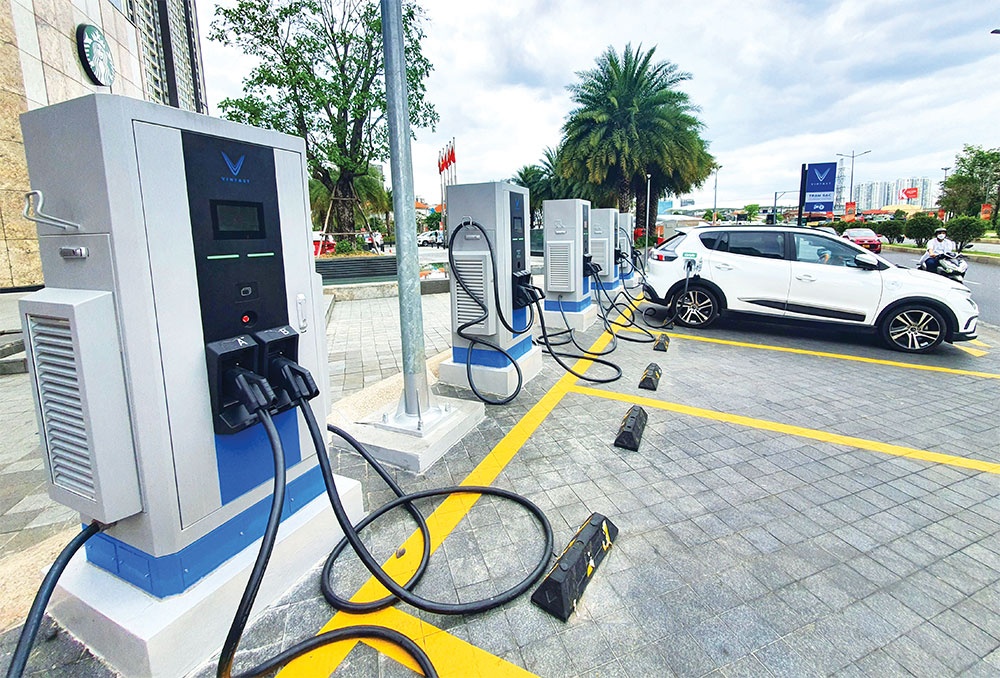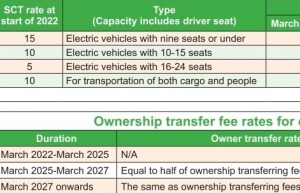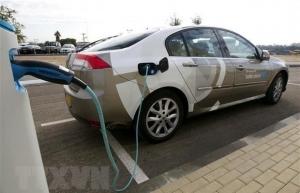Added spark wanted for EV charge stations
Last week, Hanoi police determined that the cause of the mini apartment fire in Hanoi that killed 56 people and injured dozens was an electrical short circuit on a gasonline-engine motorbike. The information dispelled rumours that the cause of the fire was a fault in an e-bike.
However in recent days, as a result of the rumours, owners of all types of buildings in the city introduced rules to limit the charging of e-bikes in basements and centralised parking areas. Some localities even issued a document prohibiting the charging of electric vehicle (EV) batteries in apartment basements.
 |
| Added spark wanted for EV charge stations, illustration photo |
27-year-old Nguyen Huong Giang, a resident of Thanh Xuan district in Hanoi complained, “The building owners and their management boards agreed that there are no EVs allowed, and no-one is allowed to recharge in the building. So where can I park my e-bike and how can I charge it?”
There are many others like Giang. On a Vietnam EV community forum of 58,000 members, many owners believe they are being forced into a corner. “Electric cars are a fairly new trend here and people often do not fully understand them. So these vehicles are often blamed if a fire incident occurs,” said Vu Ngoc Khiem, chairman of the University of Transport Technology. “The energy transition and the use of EVs to replace vehicles with internal combustion engines is an inevitable trend and a commitment of the government.”
This is not the first time that EVs have been wrongly blamed for causing fires or explosions. Still, experts said that these vehicles are not at all flammable as many people mistakenly believe, and the risk of fire and explosion in petrol vehicles is likely to be higher due to the engines inside.
“Personally, I support tightened management in apartment buildings for EV charging to ensure safety, but it must be coupled with proper solutions,” said Giang from Thanh Xuan district. “Apartment buildings should arrange separate charging areas for these types of vehicles, with 24/7 supervision and charging fees as well as storage fees.”
Infrastructure pressures
The fire incident, despite not being caused by EVs, has nevertheless highlighted the challenges for Vietnam in ensuring it can withstand the pressure of widescale use of a new type of vehicle in the long term.
According to the Ministry of Transport (MoT), at the end of 2022 the country had almost 7,800 e-cars on the road. Since the beginning of 2023, that number has increased to almost 12,300 units. To ride on the wave of acceptance, a series of domestic manufacturers and assemblers such as TMT Motor, THACO, and TC Motor, and foreign names like Wuling, Haima, Haval, and Zhidou launched the first EV products in Vietnam. Meanwhile, by the end of 2022, the country had nearly two million registered e-bikes, up 30-35 per cent compared to 2021.
According to the government’s plan, by 2040 all petrol motorbike production will stop. Along with EV manufacturers such as Son Ha, Pega, and VinFast, foreign-invested businesses in the motor industry in Vietnam that specialised petrol vehicles have also been promoting products in the e-bike segment such as SYM, Honda, Yamaha, and Piaggio.
However, the development of charging station infrastructure in Vietnam is currently behind the curve. Only VinFast owns charging ports in each locality of the country, at around 150,000 installations nationwide.
VinFast has also said in recent times that it will not share charging station infrastructure with competitors for at least the next 10 years.
A number of energy industry enterprises have begun implementing projects to build and install charging stations and charging ports to serve the needs of individuals and businesses. However, the scale of these projects is still deemed inadequate.
In August, Vietnam Kwang Yang Motor Co., Ltd. announced plans to launch a number of e-bike models in the Vietnamese market and build a system of public charging stations in the southern province of Binh Duong. At the time, it asked questions on the government information portal about installing EV charging stations in Vietnam. “Regulations in Vietnam on installing EV charging stations are still limited, so we have encountered many difficulties in understanding the related processes,” the firm said.
Tran Anh Tung, business administration head at the Ho Chi Minh University of Economics and Finance, said that building a public charging station required a large initial investment, including purchasing equipment, building infrastructure, and connecting to the power grid.
“Charging fees, managing money recovery, finding suitable land for the stations, and getting construction permits in the first place are all major challenges,” Tung said.
Standards for safety
According to the Directorate for Standards, Metrology, and Quality under the Ministry of Science and Technology, there are a number of regulations on charging posts, electrical safety, and fire prevention, but there is still a lack of standards on installation, operation, and electricity measurement at stations.
Current EV charging stations operate based on national technical standards including standards on connecting EVs to power sources, DC charging stations, and requirements of electromagnetic compatibility of chargers installed on EVs.
Doan Van Hien, managing director of Electrification Business at ABB Vietnam, said that there are many chargers available in the Vietnamese market.
“However, the lack of standards on testing and evaluating the quality of such chargers is one of the major difficulties in ensuring charging safety. The government should issue specific standards and regulations for EV charging soon so that Vietnam’s charging infrastructure system can be developed in the right direction and safety,” Hien said.
At present, there is a standard for EV charging (IEC 61851), which is widely accepted and applied in European countries. The application of this standard is also one of the viable solutions to develop a standard for Vietnam, along with some supplements and adjustments. Chargers must be installed in a well-ventilated place, convenient for fire prevention and fighting, Hien emphasised.
“Moreover, the power supply for the charger also needs to operate stably and safely. Medium and low voltage equipment, stations, and switchboards must have a coordinated protection function according to IEC standards to achieve protection requirements for overloads, interruption, and other incidents,” he added.
To ensure safe charging, consumers should choose a charger from reputable manufacturers, especially international names, or use ones that are manufactured and licensed for use in many other countries, Hien suggested.
Additionally, demands on charging stations are becoming increasingly urgent. Nguyen Ngoc Cuong, CEO of station infrastructure company EverEV JSC, stated that Vietnamese businesses are fully capable of manufacturing and installing charging stations.
“However, there is currently no domestic supplier, and we have to work with foreign vendors. Therefore, support and incentives for the production and import of equipment and components to build charging stations are essential,” Cuong said.
Khiem of the University of Transport Technology said that no apartment building can withstand hundreds of vehicles charging at the same time. Therefore, arranging top-quality public charging stations, with attendants and fees, is a practical solution.
“In the long term, localities such as Hanoi or Ho Chi Minh City need to research and stipulate that each district or ward must arrange space and build public charging points for e-bikes meeting the high standard and ensure the safety,” he said.
 | How electric vehicles can shape the auto industry In order to implement Vietnam’s net-zero commitments, one of the solutions by the government is to use more electric vehicles (EVs) as a means of transportation for the step-by-step replacement of motor vehicles powered by conventional internal combustion engines. |
 | Deputy PM stresses need to encourage use of electric vehicles Deputy Prime Minister Tran Hong Ha stressed the need to incentivise the conversion of fossil fuel-powered vehicles to electric vehicles and other types of clean energy. |
What the stars mean:
★ Poor ★ ★ Promising ★★★ Good ★★★★ Very good ★★★★★ Exceptional
Related Contents
Latest News
More News
- Heavy industries set for pilot greenhouse gas quotas (December 25, 2025 | 10:00)
- Swedfund invests in MSME growth and climate action in Vietnam (December 19, 2025 | 11:42)
- GreenYellow brings solar energy to light up remote schools in Tuyen Quang province (December 19, 2025 | 08:00)
- Charge+, Grab partner to develop EV charging network in Vietnam (December 18, 2025 | 17:11)
- Linking sci-tech and innovation to Vietnam’s net-zero future (December 18, 2025 | 14:31)
- Driving double-digit growth through green and circular transformation in Vietnam (December 17, 2025 | 09:00)
- Standard Chartered and ACCA deepen collaboration to develop Vietnam’s talent for a sustainable future (December 15, 2025 | 18:18)
- Schaeffler reports strong early output from Dong Nai solar project (December 12, 2025 | 15:16)
- Forestry conference highlights biodiversity and sustainability goals (December 09, 2025 | 13:35)
- Home Credit honoured among top 10 sustainable companies in trade and services (December 09, 2025 | 12:18)

 Tag:
Tag:




















 Mobile Version
Mobile Version